
Question Number 2917 by Rasheed Soomro last updated on 30/Nov/15
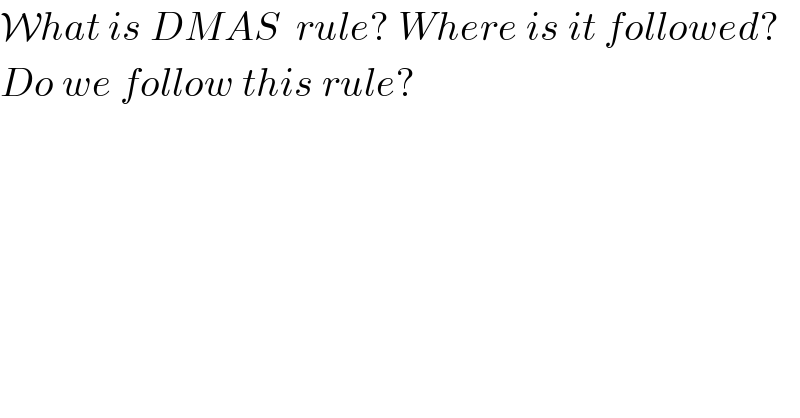
$$\mathcal{W}{hat}\:{is}\:{DMAS}\:\:{rule}?\:{Where}\:{is}\:{it}\:{followed}? \\ $$$${Do}\:{we}\:{follow}\:{this}\:{rule}?\: \\ $$
Answered by 123456 last updated on 30/Nov/15
![if i understanded it about order of operation like 1+2×3=1+6=7 1+2×3≠3×3=9 Division Multiplication Adition Subtration 48÷2 (9+3)= 288 or 2 however in general if you want avoid confusion is beter to use patents, like 48 ÷[2(9+3)]=2 or (48 ÷2) (9+3)=288](Q2918.png)
$$\mathrm{if}\:\mathrm{i}\:\mathrm{understanded}\:\mathrm{it}\:\mathrm{about}\:\mathrm{order}\:\mathrm{of}\:\mathrm{operation} \\ $$$$\mathrm{like} \\ $$$$\mathrm{1}+\mathrm{2}×\mathrm{3}=\mathrm{1}+\mathrm{6}=\mathrm{7} \\ $$$$\mathrm{1}+\mathrm{2}×\mathrm{3}\neq\mathrm{3}×\mathrm{3}=\mathrm{9} \\ $$$$\mathrm{Division}\:\mathrm{Multiplication}\:\mathrm{Adition}\:\mathrm{Subtration} \\ $$$$\mathrm{48}\boldsymbol{\div}\mathrm{2}\:\left(\mathrm{9}+\mathrm{3}\right)=\:\mathrm{288}\:\mathrm{or}\:\mathrm{2} \\ $$$$\mathrm{however}\:\mathrm{in}\:\mathrm{general}\:\mathrm{if}\:\mathrm{you}\:\mathrm{want}\:\mathrm{avoid} \\ $$$$\mathrm{confusion}\:\mathrm{is}\:\mathrm{beter}\:\mathrm{to}\:\mathrm{use}\:\mathrm{patents},\:\mathrm{like} \\ $$$$\mathrm{48}\:\boldsymbol{\div}\left[\mathrm{2}\left(\mathrm{9}+\mathrm{3}\right)\right]=\mathrm{2} \\ $$$$\mathrm{or} \\ $$$$\left(\mathrm{48}\:\boldsymbol{\div}\mathrm{2}\right)\:\left(\mathrm{9}+\mathrm{3}\right)=\mathrm{288} \\ $$
Commented by Rasheed Soomro last updated on 30/Nov/15
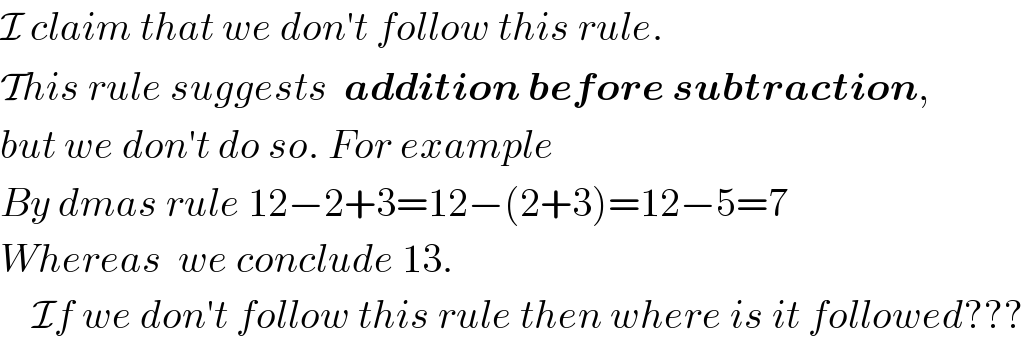
$$\mathcal{I}\:{claim}\:{that}\:{we}\:{don}'{t}\:{follow}\:{this}\:{rule}. \\ $$$$\mathcal{T}{his}\:{rule}\:{suggests}\:\:\boldsymbol{{addition}}\:\boldsymbol{{before}}\:\boldsymbol{{subtraction}}, \\ $$$${but}\:{we}\:{don}'{t}\:{do}\:{so}.\:{For}\:{example} \\ $$$${By}\:{dmas}\:{rule}\:\mathrm{12}−\mathrm{2}+\mathrm{3}=\mathrm{12}−\left(\mathrm{2}+\mathrm{3}\right)=\mathrm{12}−\mathrm{5}=\mathrm{7} \\ $$$${Whereas}\:\:{we}\:{conclude}\:\mathrm{13}. \\ $$$$\:\:\:\:\mathcal{I}{f}\:{we}\:{don}'{t}\:{follow}\:{this}\:{rule}\:{then}\:{where}\:{is}\:{it}\:{followed}??? \\ $$
Commented by Filup last updated on 30/Nov/15

$$\mathrm{When}\:\mathrm{you}\:\mathrm{have},\:\mathrm{addition}\:\mathrm{or}\:\mathrm{subtraction}, \\ $$$$\mathrm{you}\:\mathrm{can}\:\mathrm{do}\:\mathrm{it}\:\mathrm{in}\:\mathrm{any}\:\mathrm{order}\:\mathrm{if}\:\mathrm{you}\:\mathrm{make} \\ $$$$\mathrm{all}\:\mathrm{terms}\:\mathrm{positive}\:\:−\mathrm{7}=+\left(−\mathrm{7}\right) \\ $$$$\mathrm{And}\:\mathrm{you}\:\mathrm{always}\:\mathrm{work}\:\mathrm{left}\:\mathrm{to}\:\mathrm{right} \\ $$$$ \\ $$
Commented by prakash jain last updated on 30/Nov/15

$$\mathrm{DM}\:\mathrm{is}\:\mathrm{Division}\:\mathrm{or}\:\mathrm{Multiplication}\:\mathrm{from}\:\mathrm{L}\:\mathrm{to}\:\mathrm{R} \\ $$$$\mathrm{AS}\:\mathrm{is}\:\mathrm{Adition}\:\mathrm{or}\:\mathrm{Subtration}\:\mathrm{from}\:\mathrm{L}\:\mathrm{to}\:\mathrm{R} \\ $$$$\mathrm{Rule}\:\mathrm{does}\:\mathrm{not}\:\mathrm{give}\:\mathrm{priority}\:\mathrm{to}\:\mathrm{addition} \\ $$$$\mathrm{over}\:\mathrm{subtraction}.\:\mathrm{Also}\:\mathrm{Same}\:\mathrm{priority}\:\mathrm{is} \\ $$$$\mathrm{given}\:\mathrm{to}\:\mathrm{Multiplication}\:\mathrm{and}\:\mathrm{Division}. \\ $$$$\mathrm{Some}\:\mathrm{other}\:\mathrm{acronymns} \\ $$$$\mathrm{PEMDAS}:\:\mathrm{Multiplication}\:\mathrm{even}\:\mathrm{though} \\ $$$$\mathrm{it}\:\mathrm{appears}\:\mathrm{before}\:\mathrm{division}\:\mathrm{is}\:\mathrm{given}\:\mathrm{the}\:\mathrm{same} \\ $$$$\mathrm{priority}.\:\mathrm{All}\:\mathrm{expressions}\:\mathrm{are}\:\mathrm{always}\:\mathrm{evaluated} \\ $$$$\mathrm{from}\:\mathrm{left}\:\mathrm{to}\:\mathrm{right}. \\ $$
Commented by Filup last updated on 30/Nov/15
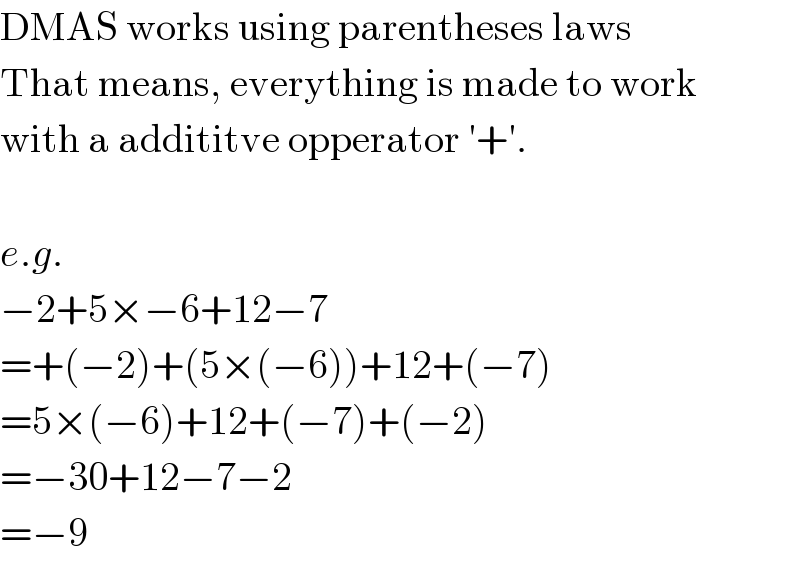
$$\mathrm{DMAS}\:\mathrm{works}\:\mathrm{using}\:\mathrm{parentheses}\:\mathrm{laws} \\ $$$$\mathrm{That}\:\mathrm{means},\:\mathrm{everything}\:\mathrm{is}\:\mathrm{made}\:\mathrm{to}\:\mathrm{work} \\ $$$$\mathrm{with}\:\mathrm{a}\:\mathrm{addititve}\:\mathrm{opperator}\:'+'. \\ $$$$ \\ $$$${e}.{g}. \\ $$$$−\mathrm{2}+\mathrm{5}×−\mathrm{6}+\mathrm{12}−\mathrm{7} \\ $$$$=+\left(−\mathrm{2}\right)+\left(\mathrm{5}×\left(−\mathrm{6}\right)\right)+\mathrm{12}+\left(−\mathrm{7}\right) \\ $$$$=\mathrm{5}×\left(−\mathrm{6}\right)+\mathrm{12}+\left(−\mathrm{7}\right)+\left(−\mathrm{2}\right) \\ $$$$=−\mathrm{30}+\mathrm{12}−\mathrm{7}−\mathrm{2} \\ $$$$=−\mathrm{9} \\ $$
Commented by Rasheed Soomro last updated on 30/Nov/15
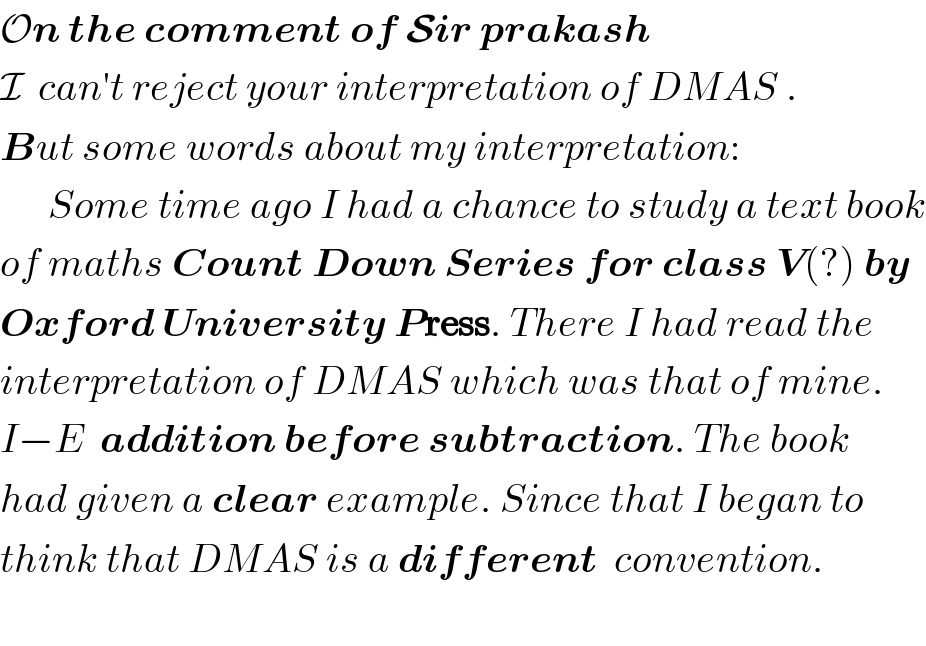
$$\mathcal{O}\boldsymbol{{n}}\:\boldsymbol{{the}}\:\boldsymbol{{comment}}\:\boldsymbol{{of}}\:\boldsymbol{\mathcal{S}{ir}}\:\boldsymbol{{prakash}} \\ $$$$\mathcal{I}\:\:{can}'{t}\:{reject}\:{your}\:{interpretation}\:{of}\:{DMAS}\:. \\ $$$$\boldsymbol{{B}}{ut}\:{some}\:{words}\:{about}\:{my}\:{interpretation}: \\ $$$$\:\:\:\:\:\:{Some}\:{time}\:{ago}\:{I}\:{had}\:{a}\:{chance}\:{to}\:{study}\:{a}\:{text}\:{book} \\ $$$${of}\:{maths}\:\boldsymbol{{Count}}\:\boldsymbol{{Down}}\:\boldsymbol{{Series}}\:\boldsymbol{{for}}\:\boldsymbol{{class}}\:\boldsymbol{{V}}\left(?\right)\:\boldsymbol{{by}} \\ $$$$\boldsymbol{{Oxford}}\:\boldsymbol{{University}}\:\boldsymbol{{P}\mathrm{ress}}.\:{There}\:{I}\:{had}\:{read}\:{the}\: \\ $$$${interpretation}\:{of}\:{DMAS}\:{which}\:{was}\:{that}\:{of}\:{mine}. \\ $$$${I}−{E}\:\:\boldsymbol{{addition}}\:\boldsymbol{{before}}\:\boldsymbol{{subtraction}}.\:{The}\:{book} \\ $$$${had}\:{given}\:{a}\:\boldsymbol{{clear}}\:{example}.\:{Since}\:{that}\:{I}\:{began}\:{to} \\ $$$${think}\:{that}\:{DMAS}\:{is}\:{a}\:\boldsymbol{{different}}\:\:{convention}. \\ $$$$ \\ $$
Commented by Filup last updated on 01/Dec/15
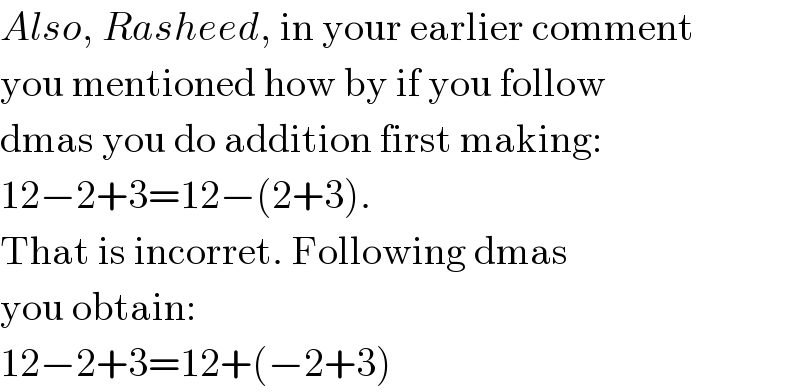
$${Also},\:{Rasheed},\:\mathrm{in}\:\mathrm{your}\:\mathrm{earlier}\:\mathrm{comment} \\ $$$$\mathrm{you}\:\mathrm{mentioned}\:\mathrm{how}\:\mathrm{by}\:\mathrm{if}\:\mathrm{you}\:\mathrm{follow} \\ $$$$\mathrm{dmas}\:\mathrm{you}\:\mathrm{do}\:\mathrm{addition}\:\mathrm{first}\:\mathrm{making}: \\ $$$$\mathrm{12}−\mathrm{2}+\mathrm{3}=\mathrm{12}−\left(\mathrm{2}+\mathrm{3}\right). \\ $$$$\mathrm{That}\:\mathrm{is}\:\mathrm{incorret}.\:\mathrm{Following}\:\mathrm{dmas} \\ $$$$\mathrm{you}\:\mathrm{obtain}: \\ $$$$\mathrm{12}−\mathrm{2}+\mathrm{3}=\mathrm{12}+\left(−\mathrm{2}+\mathrm{3}\right) \\ $$
Commented by Filup last updated on 01/Dec/15
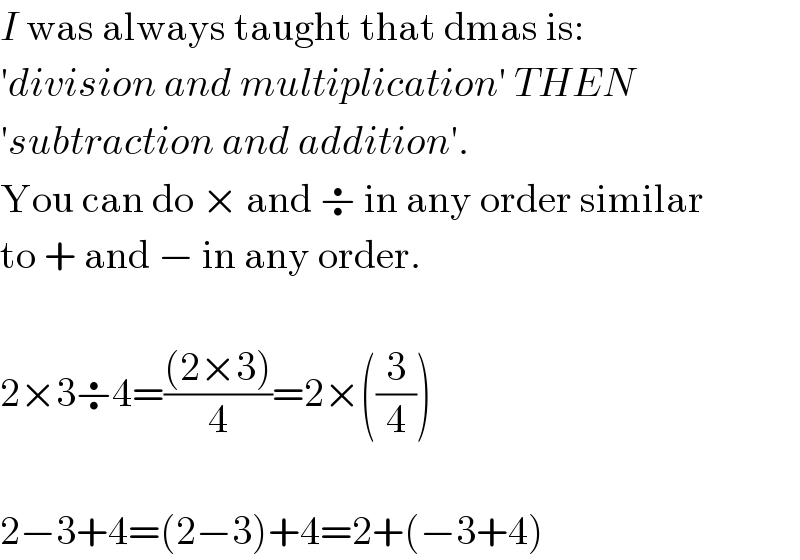
$${I}\:\mathrm{was}\:\mathrm{always}\:\mathrm{taught}\:\mathrm{that}\:\mathrm{dmas}\:\mathrm{is}: \\ $$$$'{division}\:{and}\:{multiplication}'\:{THEN} \\ $$$$'{subtraction}\:{and}\:{addition}'. \\ $$$$\mathrm{You}\:\mathrm{can}\:\mathrm{do}\:×\:\mathrm{and}\:\boldsymbol{\div}\:\mathrm{in}\:\mathrm{any}\:\mathrm{order}\:\mathrm{similar} \\ $$$$\mathrm{to}\:+\:\mathrm{and}\:−\:\mathrm{in}\:\mathrm{any}\:\mathrm{order}. \\ $$$$ \\ $$$$\mathrm{2}×\mathrm{3}\boldsymbol{\div}\mathrm{4}=\frac{\left(\mathrm{2}×\mathrm{3}\right)}{\mathrm{4}}=\mathrm{2}×\left(\frac{\mathrm{3}}{\mathrm{4}}\right) \\ $$$$ \\ $$$$\mathrm{2}−\mathrm{3}+\mathrm{4}=\left(\mathrm{2}−\mathrm{3}\right)+\mathrm{4}=\mathrm{2}+\left(−\mathrm{3}+\mathrm{4}\right) \\ $$
Commented by Rasheed Soomro last updated on 01/Dec/15
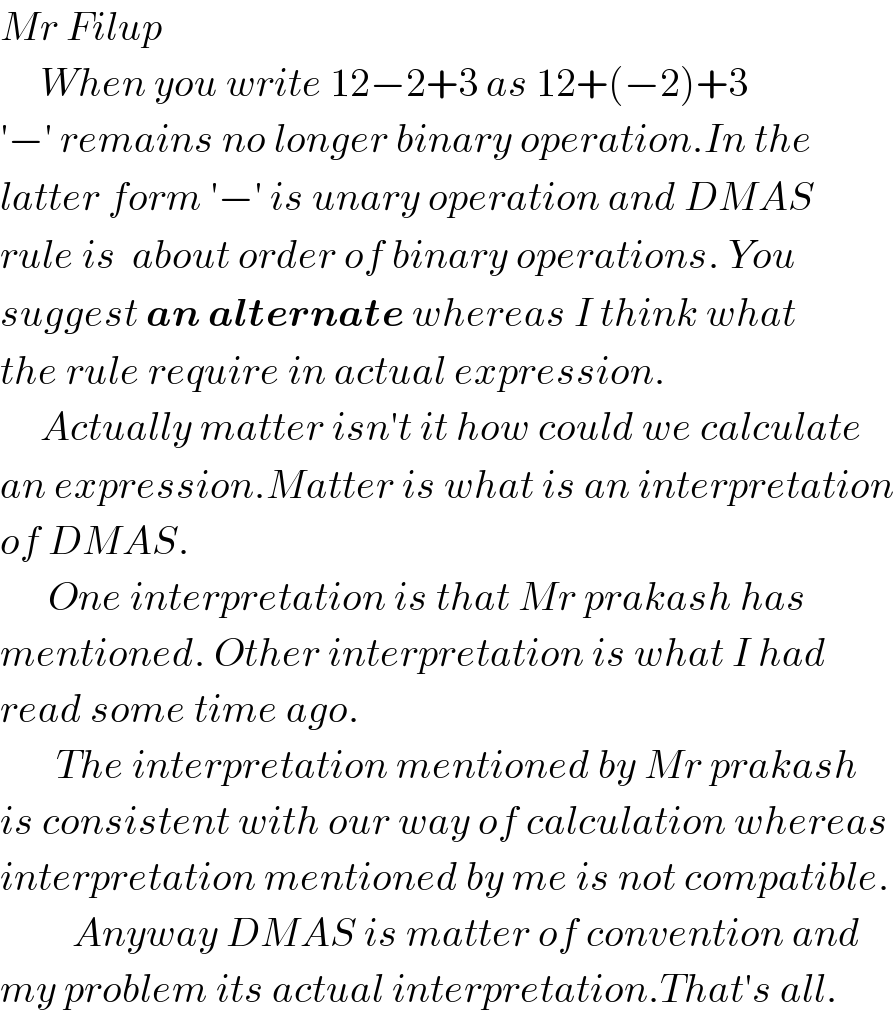
$${Mr}\:{Filup} \\ $$$$\:\:\:\:\:{When}\:{you}\:{write}\:\mathrm{12}−\mathrm{2}+\mathrm{3}\:{as}\:\mathrm{12}+\left(−\mathrm{2}\right)+\mathrm{3} \\ $$$$'−'\:{remains}\:{no}\:{longer}\:{binary}\:{operation}.{In}\:{the} \\ $$$${latter}\:{form}\:'−'\:{is}\:{unary}\:{operation}\:{and}\:{DMAS} \\ $$$${rule}\:{is}\:\:{about}\:{order}\:{of}\:{binary}\:{operations}.\:{You}\: \\ $$$${suggest}\:\boldsymbol{{an}}\:\boldsymbol{{alternate}}\:{whereas}\:{I}\:{think}\:{what} \\ $$$${the}\:{rule}\:{require}\:{in}\:{actual}\:{expression}. \\ $$$$\:\:\:\:\:{Actually}\:{matter}\:{isn}'{t}\:{it}\:{how}\:{could}\:{we}\:{calculate} \\ $$$${an}\:{expression}.{Matter}\:{is}\:{what}\:{is}\:{an}\:{interpretation} \\ $$$${of}\:{DMAS}.\: \\ $$$$\:\:\:\:\:\:{One}\:{interpretation}\:{is}\:{that}\:{Mr}\:{prakash}\:{has} \\ $$$${mentioned}.\:{Other}\:{interpretation}\:{is}\:{what}\:{I}\:{had} \\ $$$${read}\:{some}\:{time}\:{ago}. \\ $$$$\:\:\:\:\:\:\:{The}\:{interpretation}\:{mentioned}\:{by}\:{Mr}\:{prakash} \\ $$$${is}\:{consistent}\:{with}\:{our}\:{way}\:{of}\:{calculation}\:{whereas} \\ $$$${interpretation}\:{mentioned}\:{by}\:{me}\:{is}\:{not}\:{compatible}. \\ $$$$\:\:\:\:\:\:\:\:\:{Anyway}\:{DMAS}\:{is}\:{matter}\:{of}\:{convention}\:{and} \\ $$$${my}\:{problem}\:{its}\:{actual}\:{interpretation}.{That}'{s}\:{all}. \\ $$
Commented by 123456 last updated on 01/Dec/15
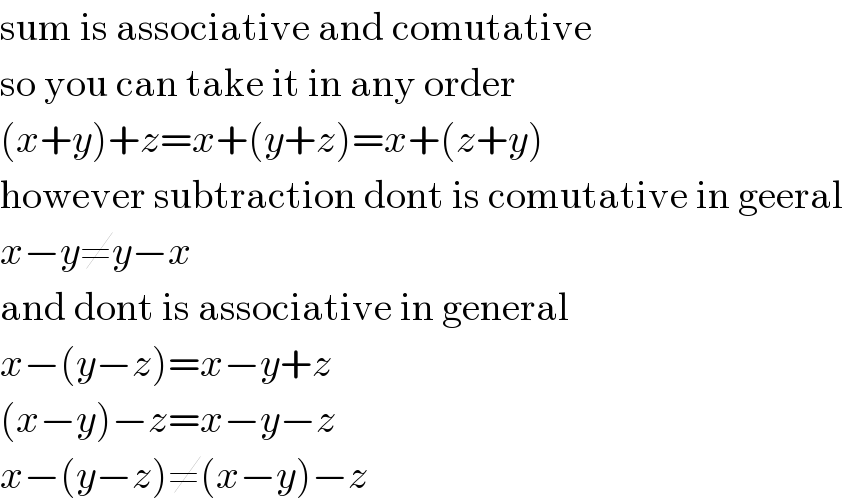
$$\mathrm{sum}\:\mathrm{is}\:\mathrm{associative}\:\mathrm{and}\:\mathrm{comutative} \\ $$$$\mathrm{so}\:\mathrm{you}\:\mathrm{can}\:\mathrm{take}\:\mathrm{it}\:\mathrm{in}\:\mathrm{any}\:\mathrm{order} \\ $$$$\left({x}+{y}\right)+{z}={x}+\left({y}+{z}\right)={x}+\left({z}+{y}\right) \\ $$$$\mathrm{however}\:\mathrm{subtraction}\:\mathrm{dont}\:\mathrm{is}\:\mathrm{comutative}\:\mathrm{in}\:\mathrm{geeral} \\ $$$${x}−{y}\neq{y}−{x} \\ $$$$\mathrm{and}\:\mathrm{dont}\:\mathrm{is}\:\mathrm{associative}\:\mathrm{in}\:\mathrm{general} \\ $$$${x}−\left({y}−{z}\right)={x}−{y}+{z} \\ $$$$\left({x}−{y}\right)−{z}={x}−{y}−{z} \\ $$$${x}−\left({y}−{z}\right)\neq\left({x}−{y}\right)−{z} \\ $$
Commented by 123456 last updated on 01/Dec/15
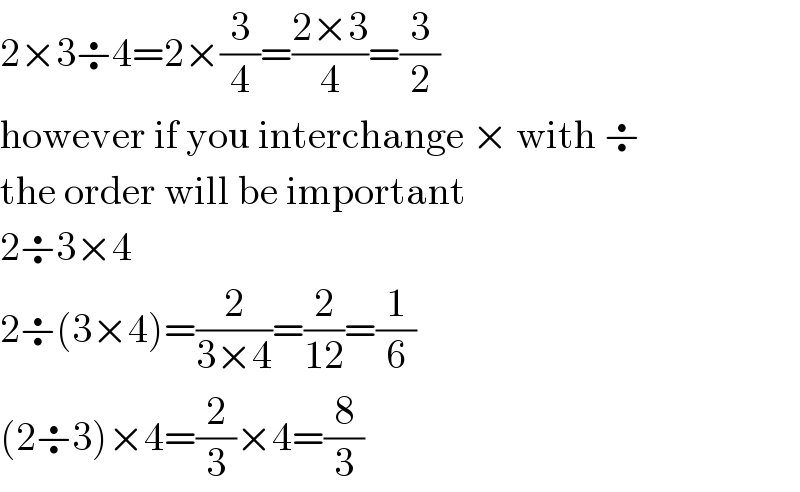
$$\mathrm{2}×\mathrm{3}\boldsymbol{\div}\mathrm{4}=\mathrm{2}×\frac{\mathrm{3}}{\mathrm{4}}=\frac{\mathrm{2}×\mathrm{3}}{\mathrm{4}}=\frac{\mathrm{3}}{\mathrm{2}} \\ $$$$\mathrm{however}\:\mathrm{if}\:\mathrm{you}\:\mathrm{interchange}\:×\:\mathrm{with}\:\boldsymbol{\div} \\ $$$$\mathrm{the}\:\mathrm{order}\:\mathrm{will}\:\mathrm{be}\:\mathrm{important} \\ $$$$\mathrm{2}\boldsymbol{\div}\mathrm{3}×\mathrm{4} \\ $$$$\mathrm{2}\boldsymbol{\div}\left(\mathrm{3}×\mathrm{4}\right)=\frac{\mathrm{2}}{\mathrm{3}×\mathrm{4}}=\frac{\mathrm{2}}{\mathrm{12}}=\frac{\mathrm{1}}{\mathrm{6}} \\ $$$$\left(\mathrm{2}\boldsymbol{\div}\mathrm{3}\right)×\mathrm{4}=\frac{\mathrm{2}}{\mathrm{3}}×\mathrm{4}=\frac{\mathrm{8}}{\mathrm{3}} \\ $$
Commented by Rasheed Soomro last updated on 01/Dec/15

$${Matter}\:{is}\:{interpretating}\:{DMAS}\:{rule}. \\ $$$$ \\ $$
Commented by Filup last updated on 01/Dec/15

$$\mathrm{It}\:\mathrm{is}\:\mathrm{more}\:\mathrm{of}\:\mathrm{a}\:\mathrm{matter}\:\mathrm{of}\:\mathrm{interperating} \\ $$$$\mathrm{the}\:\mathrm{parenthese}\:\mathrm{laws}.\:\mathrm{The}\:\mathrm{dmas}\:\mathrm{law} \\ $$$$\mathrm{is}\:\mathrm{heavily}\:\mathrm{weighed}\:\mathrm{onto}\:\mathrm{the}\:\mathrm{ability} \\ $$$$\mathrm{to}\:\mathrm{correctly}\:\mathrm{apply}\:\mathrm{parenthesise}. \\ $$
Commented by Rasheed Soomro last updated on 01/Dec/15

$$'{Multiplication}\:{has}\:{priority}\:{over}\:{addition}'.\:{No}\:{doubt}\:{it}\:\: \\ $$$${is}.\:{But}\:{this}\:{is}\:{only}\:{by}\:\boldsymbol{{convention}}.\:{It}\:{is}\:{only}\:{this} \\ $$$${convention},{for}\:{which}\:{we}\:{write}\:\mathrm{5}+\mathrm{6}×\mathrm{8}\:{instead}\:{of}\: \\ $$$$\mathrm{5}+\left(\mathrm{6}×\mathrm{8}\right).\:{This}\:{priority}\:{is}\:\boldsymbol{{man}}−\boldsymbol{{made}}.\:{If}\:{there}\:{were} \\ $$$${a}\:{convention}\:{in}\:{which}\:{addition}\:{had}\:{priority}\:{over} \\ $$$${multiplication}\:{then}\:{we}\:{had}\:{written}\:\mathrm{5}+\mathrm{6}×\mathrm{8}\:{instead}\:{of}\:\left(\mathrm{5}+\mathrm{6}\right)×\mathrm{8} \\ $$$${and}\:\mathrm{5}+\mathrm{6}×\mathrm{8}\:{were}\:{calculated}\:{as}\:{under} \\ $$$$\:\:\:\:\:\:\:\:\:\:\:\:\:\:\mathrm{5}+\mathrm{6}×\mathrm{8}=\mathrm{11}×\mathrm{8}=\mathrm{88}\: \\ $$$${So}\:\boldsymbol{{priority}}\:\:\boldsymbol{{is}}\:\boldsymbol{{purely}}\:\boldsymbol{{man}}−\boldsymbol{{made}}. \\ $$$${Dicision}\:{to}\:{parenthecise}\:{one}\:{operation}\:{and}\:{leave}\:{other} \\ $$$${is}\:{purely}\:\boldsymbol{{man}}−\boldsymbol{{made}}. \\ $$$$\mathrm{O}{ne}\:{example}\:{of}\:{priority}\:{to}\:{be}\:{man}−{made}\:{is}\:{as}\:{under}: \\ $$$$−\mathrm{3}^{\mathrm{2}} \:{is}\:{considerd}\:{as}\:−\left(\mathrm{3}^{\mathrm{2}} \right)\:{in}\:{our}\:{convention},{but}\:{in}\:{some} \\ $$$${computer}\:{programs}\:{it}\:{is}\:{treated}\:{as}\:\left(−\mathrm{3}\right)^{\mathrm{2}} . \\ $$
